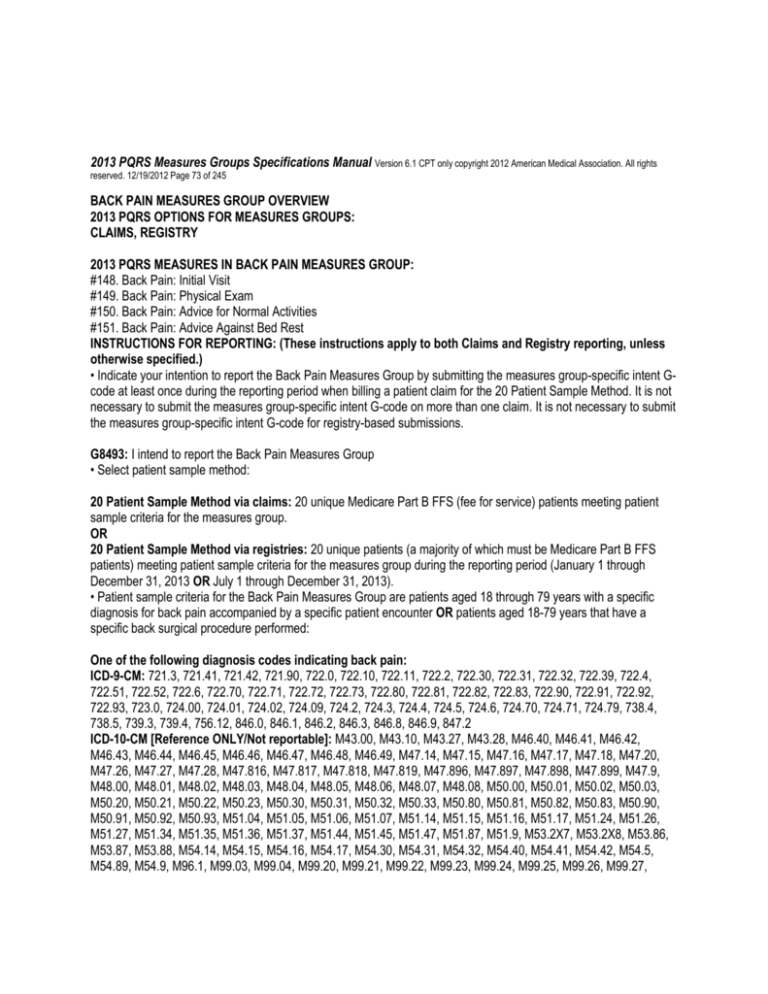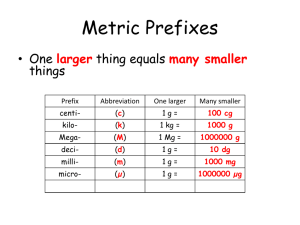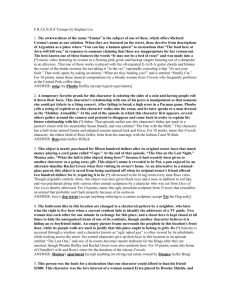
2013 PQRS Measures Groups Specifications Manual Version 6.1 CPT only copyright 2012 American Medical Association. All rights
reserved. 12/19/2012 Page 73 of 245
BACK PAIN MEASURES GROUP OVERVIEW
2013 PQRS OPTIONS FOR MEASURES GROUPS:
CLAIMS, REGISTRY
2013 PQRS MEASURES IN BACK PAIN MEASURES GROUP:
#148. Back Pain: Initial Visit
#149. Back Pain: Physical Exam
#150. Back Pain: Advice for Normal Activities
#151. Back Pain: Advice Against Bed Rest
INSTRUCTIONS FOR REPORTING: (These instructions apply to both Claims and Registry reporting, unless
otherwise specified.)
• Indicate your intention to report the Back Pain Measures Group by submitting the measures group-specific intent Gcode at least once during the reporting period when billing a patient claim for the 20 Patient Sample Method. It is not
necessary to submit the measures group-specific intent G-code on more than one claim. It is not necessary to submit
the measures group-specific intent G-code for registry-based submissions.
G8493: I intend to report the Back Pain Measures Group
• Select patient sample method:
20 Patient Sample Method via claims: 20 unique Medicare Part B FFS (fee for service) patients meeting patient
sample criteria for the measures group.
OR
20 Patient Sample Method via registries: 20 unique patients (a majority of which must be Medicare Part B FFS
patients) meeting patient sample criteria for the measures group during the reporting period (January 1 through
December 31, 2013 OR July 1 through December 31, 2013).
• Patient sample criteria for the Back Pain Measures Group are patients aged 18 through 79 years with a specific
diagnosis for back pain accompanied by a specific patient encounter OR patients aged 18-79 years that have a
specific back surgical procedure performed:
One of the following diagnosis codes indicating back pain:
ICD-9-CM: 721.3, 721.41, 721.42, 721.90, 722.0, 722.10, 722.11, 722.2, 722.30, 722.31, 722.32, 722.39, 722.4,
722.51, 722.52, 722.6, 722.70, 722.71, 722.72, 722.73, 722.80, 722.81, 722.82, 722.83, 722.90, 722.91, 722.92,
722.93, 723.0, 724.00, 724.01, 724.02, 724.09, 724.2, 724.3, 724.4, 724.5, 724.6, 724.70, 724.71, 724.79, 738.4,
738.5, 739.3, 739.4, 756.12, 846.0, 846.1, 846.2, 846.3, 846.8, 846.9, 847.2
ICD-10-CM [Reference ONLY/Not reportable]: M43.00, M43.10, M43.27, M43.28, M46.40, M46.41, M46.42,
M46.43, M46.44, M46.45, M46.46, M46.47, M46.48, M46.49, M47.14, M47.15, M47.16, M47.17, M47.18, M47.20,
M47.26, M47.27, M47.28, M47.816, M47.817, M47.818, M47.819, M47.896, M47.897, M47.898, M47.899, M47.9,
M48.00, M48.01, M48.02, M48.03, M48.04, M48.05, M48.06, M48.07, M48.08, M50.00, M50.01, M50.02, M50.03,
M50.20, M50.21, M50.22, M50.23, M50.30, M50.31, M50.32, M50.33, M50.80, M50.81, M50.82, M50.83, M50.90,
M50.91, M50.92, M50.93, M51.04, M51.05, M51.06, M51.07, M51.14, M51.15, M51.16, M51.17, M51.24, M51.26,
M51.27, M51.34, M51.35, M51.36, M51.37, M51.44, M51.45, M51.47, M51.87, M51.9, M53.2X7, M53.2X8, M53.86,
M53.87, M53.88, M54.14, M54.15, M54.16, M54.17, M54.30, M54.31, M54.32, M54.40, M54.41, M54.42, M54.5,
M54.89, M54.9, M96.1, M99.03, M99.04, M99.20, M99.21, M99.22, M99.23, M99.24, M99.25, M99.26, M99.27,
M99.28, M99.29, M99.30, M99.31, M99.32, M99.33, M99.34, M99.35, M99.36, M99.37, M99.38, M99.39, M99.40,
M99.41, M99.42, M99.43, M99.44, M99.45, M99.46, M99.47, M99.48, M99.49, M99.50, M99.51, M99.52, 2013
M99.53, M99.54, M99.55, M99.56, M99.57, M99.58, M99.59, M99.60, M99.61, M99.62, M99.63, M99.64, M99.65,
M99.66, M99.67, M99.68, M99.69, M99.70, M99.71, M99.72, M99.73, M99.74, M99.75, M99.76, M99.77, M99.78,
M99.79, M99.83, M99.84, Q76.2, S33.5XXA, S33.6XXA, S33.8XXA, S33.9XXA
AND
One of the following patient encounter codes: 97001, 97002, 99201, 99202, 99203, 99204, 99205, 99212, 99213,
99214, 99215
OR
One of the following back surgical procedure codes: 22210, 22214, 22220, 22222, 22224, 22226, 22532, 22533,
22534, 22548, 22554, 22556, 22558, 22585, 22590, 22595, 22600, 22612, 22614, 22630, 22632, 22818, 22819,
22830, 22840, 22841, 22842, 22843, 22844, 22845, 22846, 22847, 22848, 22849, 63001, 63003, 63005, 63011,
63012, 63015, 63016, 63017, 63020, 63030, 63035, 63040, 63042, 63043, 63044, 63045, 63046, 63047, 63048,
63055, 63056, 63057, 63064, 63066, 63075, 63076, 63077, 63078, 63081, 63082, 63085, 63086, 63087, 63088,
63090, 63091, 63101, 63102, 63103, 63170, 63172, 63173, 63180, 63182, 63185, 63190, 63191, 63194, 63195,
63196, 63197, 63198, 63199, 63200
• Report quality-data codes (QDCs) on all measures within the Back Pain Measures Group for each patient within the
eligible professional’s patient sample.
• Instructions for quality-data code reporting for each of the measures within the Back Pain Measures Group are
displayed on the next several pages. If all quality actions for the patient have been performed for all the measures
within the group, the following composite G-code may be reported in lieu of the individual quality-data codes for each
of the measures within the group. It is not necessary to submit the following composite G-code for registry-based
submissions.
Composite G-code G8502: All quality actions for the applicable measures in the Back Pain Measures Group have
been performed for this patient
• To report satisfactorily the Back Pain Measures Group for the 20 Patient Sample Method it requires all measures
for each patient within the sample to be reported where the initial visit to the clinician for each episode of back pain
or each surgery for back pain that occurred during the corresponding reporting period. If the patient’s initial visit for
this episode of back pain occurred prior to the beginning of the reporting period, report that the visit in the sample is a
subsequent visit for the episode and this will not count toward the 20 patient sample. This measures group may be
reported by more than one clinician if multiple clinicians evaluate or treat the patient for the back pain episode.
• Measures groups containing a measure with a 0% performance rate will not be counted as satisfactorily reporting
the measures group. The recommended clinical quality action must be performed on at least one patient for each
measure within the measures group reported by the eligible professional.
• When using the 20 Patient Sample Method via claims, report all measures for 20 unique Medicare Part B FFS
patients seen. When using the 20 Patient Sample Method via registries, report all measures for 20 unique patients
seen, a majority of which must be Medicare Part B FFS patients.
• For claims-based submissions, the Carrier/MAC remittance advice notice sent to the practice will show a denial
remark code (N365) for the line item on the claim containing G8493 (and G8502 if
reported) as well as all other line items containing QDCs. N365 indicates that the code is not payable and is used for
reporting/informational purposes only. Other services/codes on the claim will not be affected by the addition of a
measures group-specific intent G-code or other QDCs. The N365 remark code does NOT indicate whether the QDC
is accurate for that claim or for the measure the eligible professional is attempting to report, but does indicate that the
QDC was processed and transmitted to the NCH.
Measure #148 (NQF 0322): Back Pain: Initial Visit
DESCRIPTION:
The percentage of patients aged 18 through 79 years with a diagnosis of back pain or undergoing back surgery who
had back pain and function assessed during the initial visit to the clinician for the episode of back pain
NUMERATOR:
Patients who had all five of the following components assessed at the initial visit to the clinician for an episode of
back pain: pain assessment, functional status, patient history (including notation of presence or absence of warning
signs), assessment of prior treatment and response, and employment status
Definitions:
Pain Assessment – Must use any of the following assessment tools:
• SF-36
• Oswestry Low Back Pain Disability Questionnaire
• Roland-Morris Disability Questionnaire
• Quebec Pain Disability Scale
• Sickness Impact Profile
• Multidimensional Pain Inventory
OR
If none of the above tools are used, documentation of any of the following pain scales is acceptable:
• McGill Pain Questionnaire
• Visual analog scale
• Brief pain inventory
• Chronic pain grade
• Neuropathic pain scale
• Numerical rating scale (e.g., pain intensity 1–10)
• Verbal descriptive scale (e.g., pt. report: “burning, shooting, stabbing”)
• Faces pain scale
Functional Status Assessment – Must use any of the following assessment tools:
• SF-36
• Oswestry Low Back Pain Disability Questionnaire
• Roland-Morris Disability Questionnaire
• Quebec Pain Disability Scale
• Sickness Impact Profile
• Multidimensional Pain Inventory
OR
If none of the above tools are used, there must be documentation that activities of daily living (ADL) were assessed.
Assessment of all of the following ADLs must be documented:
• Eating
• Bathing
• Using the toilet
• Dressing
• Getting up from bed or a chair
Patient History – Documentation necessary to satisfy assessment for red flags, which can include the following:
• Indication/notation of presence or absence of red flags
• Notation of specific symptoms that may indicate the presence of red flags (examples noted below) o “Red Flags”
include:
History of cancer or unexplained weight loss
Current infection or immunosuppression
Fracture or suspected fracture
• Motor vehicle accident or industrial injury with suspicion of fracture
• Major fall with suspicion of fracture
Cauda equina syndrome or progressive neurologic deficit
• Saddle anesthesia
• Recent onset bladder dysfunction (urine retention, increased frequency, overflow incontinence)
• Recent onset fecal incontinence (loss of bowel control)
• Major motor weakness
Assessment of Prior Treatment and Response – If applicable, documentation that patient has been queried about
back pain episode(s), treatment and response. Notation could include the following:
• No prior back pain
• Diagnosis and dates of back pain reports for the previous two years, or as far back as the patient is able to provide
information
• Report from referring physician with summary of back pain history
• Patient report of history and attempted treatments, including diagnostic tests (e.g., imaging)
Employment Status – Use of either of the following assessment tools will satisfy this requirement:
• Sickness Impact Profile
• Multidimensional Pain Inventory
OR
Variables of an employment assessment can count. These variables must include documentation of the following:
• Type of work, including job tasks that may affect back pain management
• Work status (e.g., out of work, part-time work, work with or without limitations)
• If patient is not working or limited in work capacity, length of time for work limitations
• Workers’ compensation or litigation involvement
Episode – Patient with back pain who has not been seen or treated for back pain by any practitioner during the 4
months prior to the first clinical encounter with a diagnosis of back pain. If a patient has a four-month period without
treatment, and then sees both a primary care physician and a specialist, both visits are considered the initial visit with
that clinician. A new episode can either be a recurrence for a patient with prior back pain or a patient with a new
onset of back pain. The first clinical encounter after the four months without being seen or treated for back pain is
considered the beginning of the new episode.
Initial Visit – First visit to the clinician during an episode of back pain. There can only be one initial visit with each
clinician, but there can be more than one initial visit for a patient, if multiple clinicians evaluate or treat the patient for
the back pain episode. Report the appropriate Quality-Data Codes on the claim for each initial visit. For each
subsequent encounter after the initial visit with that clinician, or if the initial visit with that clinician occurred prior to the
start of the reporting period, then report 0526F as described below.
Numerator Quality-Data Coding Options for Reporting Satisfactorily:
Back Pain and Function Assessed
CPT II 1130F: Back pain and function assessed, including all of the following: Pain assessment AND functional
status AND patient history, including notation of presence or absence of “red flags” (warning signs) AND assessment
of prior treatment and response, AND employment status
OR
If patient is not eligible for this measure because back pain episode began prior to the reporting period,
report:
CPT II 0526F: Subsequent visit for episode
OR
Back Pain and Function not Assessed, Reason not Otherwise Specified
Append a reporting modifier (8P) to CPT Category II code 1130F to report circumstances when the action described
in the numerator is not performed and the reason is not otherwise specified.
1130F with 8P: Back pain and function was not assessed during the initial visit, reason not otherwise specified
Measure #149 (NQF 0319): Back Pain: Physical Exam
DESCRIPTION:
Percentage of patients aged 18 through 79 years with a diagnosis of back pain or undergoing back surgery who
received a physical examination at the initial visit to the clinician for the episode of back pain
NUMERATOR:
Patients who had a physical examination at the initial visit to the clinician for a new episode of back pain
Definitions:
Physical Examination:
For patients with radicular symptoms, documentation of physical exam must include the following, at a minimum:
• Indication of straight leg raise test
AND
• Notation of completion of neurovascular exam (a neurovascular exam must include ankle and knee reflexes;
quadriceps; ankle and great toe dorsiflexion strength; plantar flexion; muscle strength; motor testing; pulses in lower
extremities; and sensory exam)
For patients without radicular symptoms, documentation of physical exam must include the following:
• Documentation of straight leg raise, neurovascular exam or clear notation of absence or presence of neurologic
deficits
Episode – Patient with back pain who has not been seen or treated for back pain by any practitioner during the 4
months prior to the first clinical encounter with a diagnosis of back pain. If a patient has a four-month period without
treatment, and then sees both a primary care physician and a specialist, both visits are considered the initial visit with
that clinician. A new episode can either be a recurrence for a patient with prior back pain or a patient with a new
onset of back pain. The first clinical encounter after the 4 months without being seen or treated for back pain is
considered the beginning of the new episode.
Initial Visit – First visit to the clinician during an episode of back pain. There can only be one initial visit with each
clinician, but there can be more than one initial visit for a patient, if multiple clinicians evaluate or treat the patient for
the back pain episode. Report the appropriate Quality-Data Codes on the claim for each initial visit. For each
subsequent encounter after the initial visit with that clinician, or if the initial visit with that clinician occurred prior to the
start of the reporting period, then report 0526F as described below.
Numerator Quality-Data Coding Options for Reporting Satisfactorily:
Physical Exam Performed
CPT II 2040F: Physical examination on the date of the initial visit for low back pain performed, in accordance with
specifications
OR
If patient is not eligible for this measure because back pain episode began prior to the reporting period,
report:
CPT II 0526F: Subsequent visit for episode
OR
Physical Exam not Performed, Reason not Otherwise Specified
Append a reporting modifier (8P) to CPT Category II code 2040F to report circumstances when the action described
in the numerator is not performed and the reason is not otherwise specified.
2040F with 8P: Physical exam was not performed during the initial visit, reason not otherwise specified2013 PQRS
Measures Groups Specifications Manual Version 6.1 CPT only copyright 2012 American Medical Association. All rights reserved. 12/19/2012
Page 80 of 245
Measure #150 (NQF 0314): Back Pain: Advice for Normal Activities
DESCRIPTION:
The percentage of patients aged 18 through 79 years with a diagnosis of back pain or undergoing back surgery who
received advice for normal activities at the initial visit to the clinician for the episode of back pain
NUMERATOR:
Patients with documentation of advice to maintain or resume normal activities at the initial visit to the clinician for a
new episode of back pain
Definitions:
Episode – Patient with back pain who has not been seen or treated for back pain by any practitioner during the 4
months prior to the first clinical encounter with a diagnosis of back pain. If a patient has a four-month period without
treatment, and then sees both a primary care physician and a specialist, both visits are considered the initial visit with
that clinician. A new episode can either be a recurrence for a patient with prior back pain or a patient with a new
onset of back pain. The first clinical encounter after the 4 months without being seen or treated for back pain is
considered the beginning of the new episode.
Initial Visit – First visit to the clinician during an episode of back pain. There can only be one initial visit with each
clinician, but there can be more than one initial visit for a patient, if multiple clinicians evaluate or treat the patient for
the back pain episode. Report the appropriate Quality-Data Codes on the claim for each initial visit. For each
subsequent encounter after the initial visit with that clinician, or if the initial visit with that clinician occurred prior to the
start of the reporting period, then report 0526F as described below.
Numerator Quality-Data Coding Options for Reporting Satisfactorily:
Advice for Normal Activities Performed
CPT II 4245F: Patient counseled during the initial visit to maintain or resume normal activities
OR
If patient is not eligible for this measure because back pain episode began prior to the reporting period,
report:
CPT II 0526F: Subsequent visit for the episode
OR
Advice for Normal Activities not Performed, Reason not Otherwise Specified
Append a reporting modifier (8P) to CPT Category II code 4245F to report circumstances when the action described
in the numerator is not performed and the reason is not otherwise specified.
4245F with 8P: Advice for normal activities was not performed during the initial visit, reason not otherwise specified
Measure #151 (NQF 0313): Back Pain: Advice Against Bed Rest
DESCRIPTION:
The percentage of patients aged 18 through 79 years with a diagnosis of back pain or undergoing back surgery who
received advice against bed rest lasting four days or longer at the initial visit to the clinician for the episode of back
pain
NUMERATOR:
Patients with documentation of advice against bed rest lasting four days or longer at the initial visit to the clinician for
an episode of back pain
Definitions:
Episode – Patient with back pain who has not been seen or treated for back pain by any practitioner during the 4
months prior to the first clinical encounter with a diagnosis of back pain. If a patient has a four-month period without
treatment, and then sees both a primary care physician and a specialist, both visits are considered the initial visit with
that clinician. A new episode can either be a recurrence for a patient with prior back pain or a patient with a new
onset of back pain. The first clinical encounter after the 4 months without being seen or treated for back pain is
considered the beginning of the new episode.
Initial Visit – First visit to the clinician during an episode of back pain. There can only be one initial visit with each
clinician, but there can be more than one initial visit for a patient, if multiple clinicians evaluate or treat the patient for
the back pain episode. Report the appropriate Quality-Data Codes on the claim for each initial visit. For each
subsequent encounter after the initial visit with that clinician, or if the initial visit with that clinician occurred prior to the
start of the reporting period, then report 0526F as described below.
Numerator Quality-Data Coding Options for Reporting Satisfactorily:
Advice Against Bed Rest Performed
CPT II 4248F: Patient counseled during the initial visit for an episode of back pain against bed rest lasting 4 days or
longer
OR
If patient is not eligible for this measure because back pain episode began prior to the reporting period,
report:
CPT II 0526F: Subsequent visit for episode
OR
Advice Against Bed Rest not Performed, Reason not Otherwise Specified
Append a reporting modifier (8P) to CPT Category II code 4248F to report circumstances when the action described
in the numerator is not performed and the reason is not otherwise specified.
4248F with 8P: Advice against bed rest was not performed during the initial visit, reason not otherwise specified









